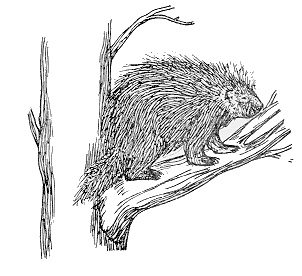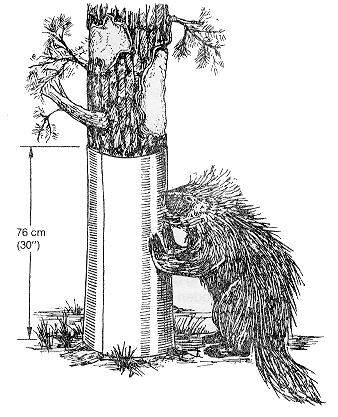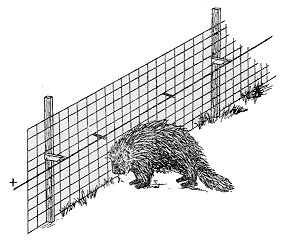| | Damage | Damage Prevention
The porcupine is Alberta's second largest rodent, measuring up to 90 cm in length and weighing as much as 12 kg (Figure 1). They live throughout the province, usually near stands of woody vegetation. The porcupine has a unique defence mechanism of up to 30,000 hardened barbed quills built into its coat.

Figure 1. Porcupines are Alberta's second largest rodent
Porcupines have poor eyesight, but their senses of hearing and smell are strong. These mammals are primarily nocturnal, feeding and travelling during darkness. They do not hibernate and are active all winter.
Unlike most other rodents, the porcupine produces only one offspring each year, requiring a gestation period of up to seven months. The young are born fully developed, with eyes open and a coat of quills. Although the young are capable of eating vegetation within a week after birth, they generally stay with the female through the summer. Juvenile survival rates are high.
Porcupines become sexually mature at two years of age and have a life expectancy of up to nine years.
Damage
Most porcupine damage occurs during the winter when woody plants become a staple diet. Extensive gnawing of branches, twigs and bark is evidence of porcupine attack. Susceptible trees include pine, spruce, poplar, elm, fruit-bearing trees and numerous shrub species. Girdling of the tree bark, if severe, will kill the plant.
In summer, porcupines can damage fruits, vegetables and succulent plants.
Occasionally, porcupines find buildings, open air sheds and other wooden structures including boat houses and piers where they can seriously damage beams and other support structures with their gnawing.
Porcupines offer a considerable threat to dogs, which never seem to learn to avoid them. Domestic stock will nuzzle porcupines, which may cause considerable medical problems if the stock are not treated promptly.
Damage Prevention
Porcupine damage can be reduced or prevented by several methods: removal, repellents or exclusion.
Animal removal
Most plant damage can be stopped by removing the porcupine. Porcupines from surrounding areas will usually not reinvade the area for some time, often several months. Consequently, animal removal is an effective prevention and control technique.
Shooting - Any resident may hunt porcupine throughout the year on lands with right of access. During winter, you can easily identify porcupine trails. As the porcupine goes through the snow, it leaves behind a continuous trail or furrow nearly 30 cm wide. Track and locate the animal and shoot it with a small calibre firearm.
Trapping - Live trapping can be successful using a wire cage trap or wooden box trap with minimum dimensions of 30 cm high, 25 cm wide and 80 cm long (roughly 12 x 10 x 32 in).
Leghold traps (sizes 2-3) and conibear traps (#220 or #330) can also be used for catching porcupines, providing a damage control permit is first obtained through the Fish and Wildlife Division of Alberta Sustainable Resource Development. The traps should be set to avoid the taking of non-target animals.
Set the trap at the base of a large tree or a leaning one near the damage site. Bait a small cubby (enclosed space) with a salt-soaked piece of leather or wood, salt mixed with cooking oil or vegetable pieces such as carrot, turnip, etc. Porcupines like salt.
Relocate the animal a good distance away (up to 45 km), and release in an non-agricultural area.
Snaring - When porcupines invade an urban community, snaring can be the easiest method of removal. In many instances, a pole snare can be maneuvred over the porcupine's head, and the animal can then be lifted into a carrying box. Remember, the pole should be strong enough to lift over 15 kg and long enough to safely herd the porcupine or to ward off any sudden attacks by the animal.
Toxicants - It is illegal to poison porcupines in Alberta.
Repellents
Skoot or thiram-based compounds are the only products that may be used for porcupines in Canada. These products can be brushed or sprayed on most vegetation. They give a bitter and offensive taste to the plant. Do not apply repellents to plants normally grown for human or animal consumption; the repellents will make the plants inedible.
Exclusion
Porcupines are excellent climbers, which reduces the effectiveness of most mechanical barriers. Individual trees can be protected by installing a 76 cm (30 in) band of sheet metal or aluminum flashing at the base of each tree (Figure 2).

Figure 2. Protect trees with a metal band.
Electric fencing around orchards, plantations and gardens will keep porcupines away. This can be done by enclosing the area with 60 cm high poultry wire and then tightly stretching the wire mesh over posts set 6 to 8 m apart. Make certain the bottom of the wire mesh is always at or below ground level.
Next, put a 12.5-gauge smooth high-tensile wire around the outside fence perimeter, 45 cm above the ground, using insulators at every post. The smooth wire must be kept no more than 4 cm away from the poultry wire. If the distance is greater, porcupines can squeeze through without receiving an adequate shock (Figure 3).

Figure 3. Electric fencing will deter porcupines.
Use insulators to hold the charged wire in the correct position between posts. Effective and inexpensive spacers can be made using hollow insultube cut at lengths slightly larger than 4 cm and pre-drilled at each end. Thread one end of the insultube on the 12.5-gauge wire, and clip the other end onto the poultry mesh using flexible wire ties.
A porcupine, when attempting to climb this barrier, will touch the charged wire with its nose or paw. The resulting shock will be enough to discourage porcupines.
Increase the height of poultry mesh and charged wire during winter to account for expected snow depths.
Conclusion
The porcupine is an interesting animal that has an important place in the environment. Porcupines are edible and have been used by humans as an emergency food. The quills are used for decoration, especially by native Canadians. The hair is very popular among fly fisherman. Porcupines may need to be controlled but should not be totally eradicated.
Prepared by:
John Bourne
Source: Agdex 684-11. Revised July 2005. |
|